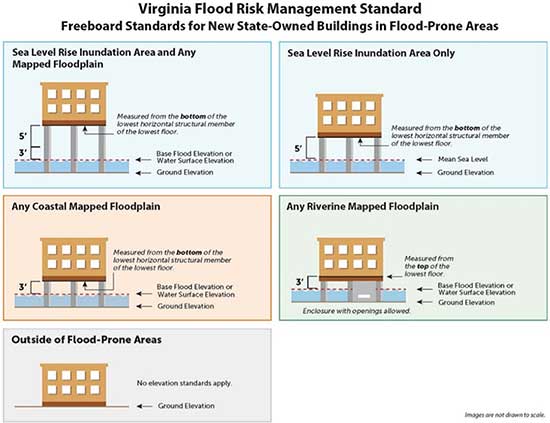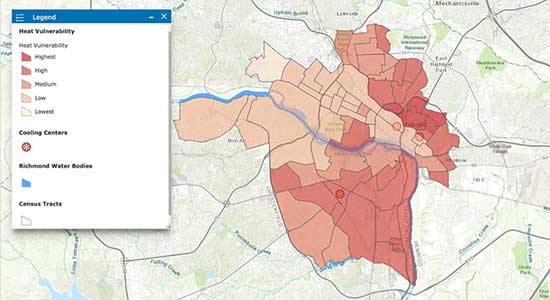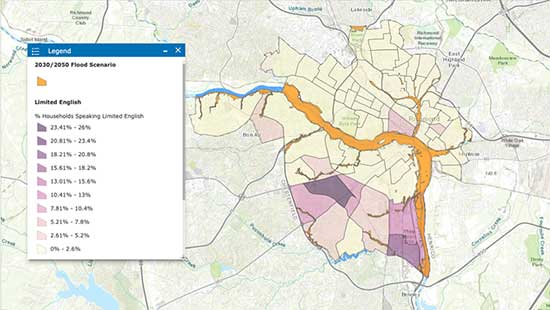News from Resilient Virginia
State and Local News
- The 2021 General Assembly Roundup
- Study on Resilient Infrastructure Recommendations Informs Real-World Implementation
- Local Resiliency Actions Around the State — Richmond and Martinsville
National News
- New Administration Charts Path to Address Climate Change
- The American Rescue Plan Promises Recovery and Resilience
Funding and Resources
- Energy Act of 2020 Accelerates Clean Energy Development
- Virginia Foundation Funds Local Resiliency
- Resilient Events Calendar
- Membership — Your support helps communities move toward resiliency!

Resilient Virginia News
Resilient Virginia in 2021: Moving from Recovery to Resilience
In the fall of 2020 a survey report was published by a joint project of George Mason University and Yale University that indicated Virginians (as well as other US communities) are interested in hearing news stories about solutions to climate impacts in their communities.
The survey report, Americans’ Interest in Climate News 2020, is an indication that, to varying degrees, people want to have a public dialogue about what their communities are doing to address the climate crises. For example, in Virginia the overall percentage is 77%, with that percentage varying from higher levels in Northern Virginia, Charlottesville, and coastal areas to lower percentages in Southwest areas.
This approach has helped influence Resilient Virginia’s direction for 2021. During this year we will strive to move beyond recovery from the pandemic and toward bringing solutions for vibrant, healthy, and equitable communities. We are announcing two initiatives for 2021 that will bring solutions to the forefront in Virginia.
2nd Resiliency Academy Series: Funding for Resiliency
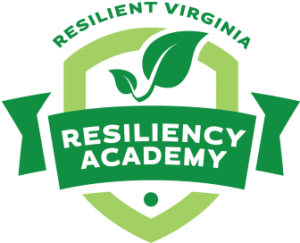 Resilient Virginia introduces our second Resiliency Academy series with Funding for Resiliency workshops. The three-workshop series will start on May 6 (1:00–2:30pm) with “Funding for Flood Prone Communities,” featuring these speakers: Russell Baxter, Deputy Director, Virginia Department of Conservation and Recreation, and Debbie Messmer, State Hazard Mitigation Officer, Virginia Department of Emergency Management (VDEM).
Resilient Virginia introduces our second Resiliency Academy series with Funding for Resiliency workshops. The three-workshop series will start on May 6 (1:00–2:30pm) with “Funding for Flood Prone Communities,” featuring these speakers: Russell Baxter, Deputy Director, Virginia Department of Conservation and Recreation, and Debbie Messmer, State Hazard Mitigation Officer, Virginia Department of Emergency Management (VDEM).
Additional workshops in May and June will focus on “Funding for Resilient Buildings and Energy” and “Funding for Economic Development, Jobs, and Justice.”
Registration for the first workshop starts April 19th. Members receive a discount on all Resilient Virginia events. Click here to check your membership status.
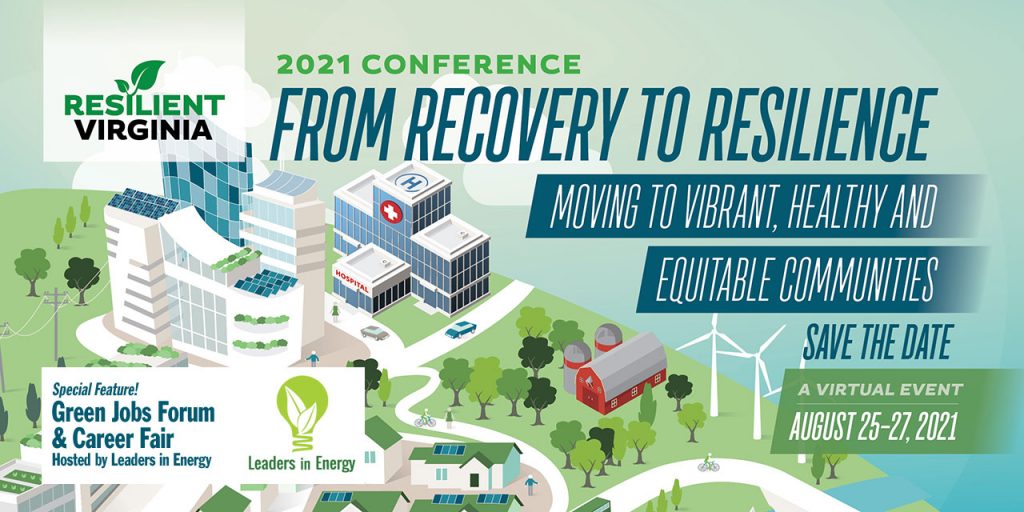
Resilient Virginia has also begun planning our 2021 Resilient Virginia Conference, which will have the theme From Recovery to Resilience: Moving to Vibrant, Healthy, and Equitable Communities. Scheduled for late August, this virtual event will feature national and regional speakers who will bring a broad perspective on resiliency solutions, as well as local success stories, state policy advances, and technical workshops on using climate assessment tools.
Find out about joining our Planning Committee or becoming a Conference Sponsor by contacting Annette Osso, Managing Director, at osso@resilientvirginia.org.

State and Local News
The 2021 General Assembly Roundup
Here are some of the bills passed this year that will move climate mitigation and resiliency forward in the state. For additional information on relevant bills, go the Virginia Conservation Networks Blog.
Transportation and Buildings
The passage of the landmark Clean Cars Standards bill (HB 1965), sponsored by Delegate Lamont Bagby, will reduce vehicle emissions and speed up electrification of vehicles — improving air quality and public health while simultaneously decreasing the largest source of carbon emissions in Virginia. Virginia now joins 14 other states and Washington, DC, in adopting clean transportation legislation. The bill makes it possible for Virginia dealerships to be included in the list of priority states to receive low- and zero-emission electric vehicles from manufacturers. A companion bill which provided for rebates was passed but not funded.
Senator Jennifer Boysko sponsored a bill (SB 1223) which adds assessment of progress in electric vehicle adoption into Virginia’s Energy Plan. Similarly, Delegate Richard Sullivan supported a bill (HB 2282) which directs the SCC to help accelerate transportation electrification through regulation and oversight.
Delegate Kelly Convirs-Fowler sponsored HB 2071, which requires the Commonwealth Transportation Board to determine whether a project has been designed to be, or the project sponsor has committed that the design will be, resilient when evaluating projects for the Six-Year Improvement Program, and to consider resiliency when establishing the Statewide Transportation Plan. The bill also requires the Commissioner of Highways to ensure resiliency is incorporated into the design standards for new construction projects.
Despite efforts by Delegate Kay Kory and Senator Boysko to bring Virginia’s current building code up to national standards, they met with little success. Senator Boysko’s Senate bill never got a hearing, and Delegate Kory’s bill (HB 2227) was heavily amended to merely require the Housing Board to consider adopting building codes from the International Energy Conservation Code (IECC).
Funding Solar and Storage
Through Delegate Kory’s HB 1919 bill, local authorities can now establish local Green Banks, which are important financing mechanisms to create jobs in low- to moderate-income communities that otherwise might not receive financing for clean energy and energy efficiency. Notably, with the passage of this bill, Virginia may receive federal funding for green bank seed money grants, which President Biden has indicated he supports.
The Brightfields Act (HB 1925), supported by Delegate Terry Kilgore, establishes the Virginia Brownfield and Coal Mine Renewable Energy Grant Fund, which could award grants up to $35 million/year on a competitive basis to support wind, solar, or geothermal projects sited on formerly mined lands or brownfields.
Delegate Chris Hurst and Senator John Edwards passed legislation (HB 2034 + SB 1420) to extend solar Power Purchase Agreements (PPAs) availability in SW Virginia, which include municipalities and public schools. PPAs are a solar project funding mechanism which allows schools and governments to choose affordable, clean energy options from third-party providers.
Delegate Rodney Willett’s HB 2148 makes energy storage and hybrid projects more feasible by streamlining project approval requirements. With this legislation, energy storage projects are expected to produce over $3 billion in investment over the next 15 years, boosting workforce development in Virginia.
Climate Mitigation
Several studies and groups were also established so that our legislators can determine the best way to reduce our carbon emissions. The DEQ will develop a comprehensive greenhouse gas emissions inventory to be updated and published every 4 years, with oversight given to the State Air Pollution Control Board to help develop the inventory. A Carbon Sequestration Task Force has also been established to review methods and set goals to sequester carbon in our natural environment.
Agriculture
Delegate Eileen Filler-Corn’s HB 2203 bill establishes the Virginia Agriculture Food Assistance Program and a supporting Fund to encourage and reimburse farmers who donate or sell produce to charitable organizations.
Senator Emmett Hanger’s SB 1162 bill provides enhanced tax credits for the implementation of agricultural BMPs to promote improved water quality.
Delegate Sam Rasoul’s HB 2068 bill establishes the Local Food and Farming Infrastructure Grant Program, which rewards grants up to $25,000 for sustainable farming practices and infrastructure on a competitive basis.
Equity
This bill — HJ 538 — by Delegate Lashrecse Aird recognizes that state agencies should strategize to limit contamination of water and to mitigate the impact of climate change on freshwater resources. With this bill, Virginia acknowledges its responsibility to protect water resources and ensure equitable access to clean water for growing food, cooking, bathing, and drinking.
Delegate Delores McQuinn’s HJ 542 gave the Department of Rail and Public Transportation $900,000 to conduct a Transit Equity & Modernization Study to estimate the cost of adding transit necessities such as benches and shelters, bus electrification, GPS tracking, integrated payments, and mechanisms for more rider input and decision-making in transit systems throughout Virginia.
Source: Virginia Conservation Network website.
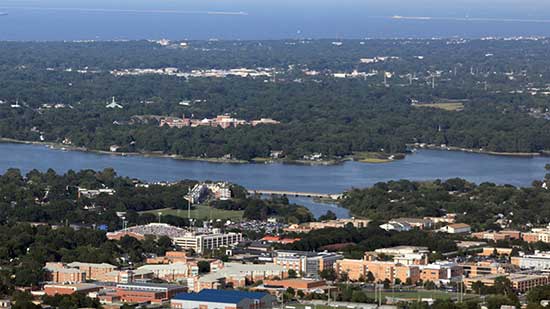 Aerial view of Old Dominion University near the James River. Courtesy of Clark Nexsen.
Aerial view of Old Dominion University near the James River. Courtesy of Clark Nexsen.
Study on Resilient Infrastructure Recommendations Informs Real-World Implementation
Editor’s Note: Resilient Virginia invites Annual Sponsors to write guest articles for the newsletter and website. We thank Chris Stone, Senior Principal at Clark Nexsen, a Community Leader Annual Sponsor, for providing this article.
As climate change continues to drive sea level rise, many coastal regions are being forced to reconsider their typical development practices and adopt new standards to improve resiliency. In November 2018, Virginia Governor Ralph Northam issued an executive order with directives to standardize and set minimum building requirements for all state-owned buildings. Clark Nexsen and Old Dominion University (ODU) tested these new recommendations with a study examining 12 buildings on ODU’s campus.
At the mouth of the James River with a maximum elevation of less than seven feet above sea level, Old Dominion University is at a high risk for climate change-related flooding from virtually all sides. The campus is bounded by the Elizabeth River to the south and west, the James River to the northwest, and the Chesapeake Bay to the northeast. Model projections anticipate that rising seas, subsidence, and increased precipitation will only continue to increase flooding and storm events in the region.
Factors like these contributed Executive Order 24, ”Increasing Virginia’s Resilience to Sea Level Rise and Natural Hazards.” To stay ahead of the curve, the legislation provides detailed steps to building flood-resilient infrastructure in coastal Virginia.
The Goal: Develop A Methodology for Implementing Resiliency Recommendations
Clark Nexsen collaborated with ODU to evaluate and report on the recommendations contained in the ”Recommendations for Freeboard Standards for State-Owned Buildings in the Commonwealth of Virginia” from the Commonwealth Center for Recurrent Flooding Resiliency (CCRFR). The overall objective of the study was to develop a standardized methodology for implementation of the CCRFR recommendations and to contrast that against the current standard from the American Society of Civil Engineers (ASCE) Standard 24-14, Flood Resistant Design and Construction, and ASCE Standard 24-14, Flood Resistant Design and Construction, including the future impact of sea level rise.
By the end of the study, the project team had developed methodologies that demonstrated the complex relationships and various infrastructure components affected by recurrent flooding and sea level rise. In a nutshell, we found that to develop a project, you had to identify the location of the 100- and 500-year flood plain limits (easier said than done) and what the level of the water would be to determine the finished floor elevation. These data points impact substantial aspects of building function, from the equipment servicing the building to how to access the building in the future. The findings of our study ultimately resulted in several refinements and clarifications to CCRFR’s report and key recommendations to the Governor.
From Analysis to Action
Coming full circle from analysis to action, our collaborative study with ODU was central to informing the new standards recently signed into law by Governor Northam as Executive Order 45 (EO-45). EO-45 announced the country’s strongest flood protections for state-owned property to safeguard against the impacts of climate change. “It is simply common sense to protect against the risk of flooding, because climate change is driving sea levels higher and making storms more intense,” said Governor Northam. “Flooding remains the most common and costly natural disaster in Virginia and in the United States, and our state government is getting prepared. These standards will protect taxpayers by establishing critical protections for new state-owned property.”
Virginia Flood Risk Management Standard. Credit: Commonwealth of Virginia.
“Executive Order Forty-Five is a critical component of the Coastal Resilience Master Plan that we are working to complete,” said Rear Admiral (Retired) Ann C. Phillips, Special Assistant to the Governor for Coastal Adaptation and Protection. “This Order sets forth a necessary foundation as we finalize the first version of that plan in the months ahead.”
The new executive order creates the Virginia Flood Risk Management Standard to improve flood protection in flood prone areas across the state, further encouraging smart and resilient construction of state buildings and establishing a “freeboard” standard that increases protection of state-owned buildings in coastal and riverine floodplains. A first of its kind for any state, the standard incorporates science-based sea level rise projections that NOAA has developed and adopted. Under the order, state-owned buildings built to certain elevation standards to protect them from flooding. The new standards will apply to all state-owned buildings authorized for construction after January 1, 2021.
Note: This is an excerpt of the full article which can be read here.
Chris Stone, PE, F.NSPE, F.ASCE, LEED AP is a senior principal at Clark Nexsen with years of experience in design and management. He is passionate about sustainability and resilient design, with a focus on resilient infrastructure and its impact on the urban setting. To connect with Chris, please email cstone@clarknexsen.com.
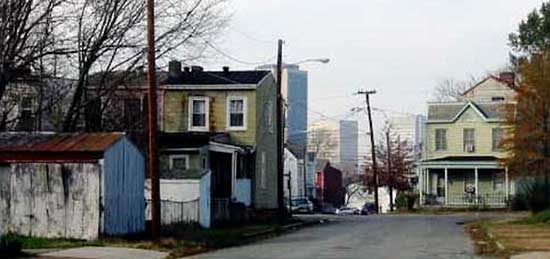 Union Hill neighborhood and downtown skyline, Source: City of Richmond Office of Sustainability.
Union Hill neighborhood and downtown skyline, Source: City of Richmond Office of Sustainability.
Local Resiliency Actions Around the State
This month we are highlighting resiliency actions that are being carried out by local governments around the state.
Resiliency Topic: Identifying Equity Concerns
Richmond’s Climate Equity Index
Richmond, Virginia is a historic and diverse city, boasting many unique neighborhoods and communities. As with any city, policies and actions have shaped these neighborhoods throughout history, deepening the inequality and inequity within the population. This history has created a hurdle of social vulnerability that must be tackled when planning for the resilience of the city.
To properly plan a city’s resilience efforts, it is imperative to understand the social vulnerability of the different communities that make up the city. Considering this, Richmond’s Office of Sustainability created the Climate Equity Index (CEI). After a year of research and development, this interactive tool launched in 2020 and allows them to identify neighborhoods (census tracts) that are most vulnerable to climate risks, which can help leaders shape policies and strategies to better plan for the city’s resilience.
How the Climate Equity Index Came About
When Alicia Zatcoff, Richmond’s Sustainability Manager, and her team started to work on a Climate Vulnerability and Risk Assessment as part of the city’s RVAgreen 2050 equitable climate action and resilience planning initiative, they recognized a social vulnerability analysis was needed as part of the larger process. Based on their research they selected 39 factors (demographic, health, housing, and others) to gather data at the census tract level. These factors were all weighted equally and combined using a statistical analysis. The results of this analysis can be used to identify Richmond neighborhoods that have a higher vulnerability to climate impacts. It is able to narrow in on a set of factors to help the government or other organization tailor a particular program. It also has the ability to grow as new situations arise — for example, they were able to add a layer for COVID vulnerability. Best of all, this tool is available for anyone to explore.
Examples of How the Climate Equity Index Can Be Used
With the ability to overlay maps, the CEI tool can provide invaluable data when planning resilience policies and strategies. For example:
Overlaying maps of heat sensitive areas with locations of cooling stations can help determine if the most vulnerable population has the ability to seek relief during a heat wave.
Overlaying maps of flood scenarios with households speaking limited English would help determine where emergency notices would need to be sent out in multiple languages so every citizen had the opportunity to evacuate during a flood.
Conclusion
With the Climate Equity Index live and available for public use, the City is now looking to their citizens for input on the RVAgreen 2050 equitable climate action and resilience plan. Using community feedback, the City of Richmond hopes to have the City-wide RVAgreen 2050 climate action and resilience plan finalized by Earth Day 2022.
Note: This article is excerpted from a case study written by Trisha Porter, 2020 VA Tech CLIGS student. She is researching and writing case studies on resiliency initiatives by local governments around the state. These case studies will be featured on the NOAA US Climate Resilience Toolkit website as well as on the Resilient Virginia website.
Please contact Annette Osso, Managing Director, Resilient Virginia, if you would like your community to be included as a case study.
Resiliency Topic: Energy Security
Martinsville Embarks on an Energy Storage Project
Artist rendering of the City of Martinsville site. Image: Wärtsilä Corporation.
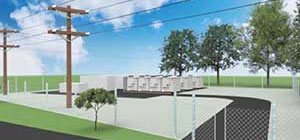
In the last quarter of 2020, the city of Martinsville and its municipal utility department finalized plans with Wärtsilä Corporation, a Finnish company with state headquarters in Herndon, Virginia, to build a commercial battery storage facility that will ultimately provide substantial operational savings.
This project will feature the company’s newest modular energy storage system, and is designed to reduce transmission and capacity peak values while also participating in the PJM interconnection frequency response market opportunities. The system size will be at 9MW/15.6MWh and will allow the utility to reduce peak demand by 9MW.
The project, scheduled for completion in the second half of 2021, will ultimately allow the city to make substantial savings on its electricity system costs. The project is being carried out with Appalachian Electric Power (AEP), which will pay for construction of the $8.35 million facility and will own, operate, and maintain the facility. Martinsville will initially receive 10% of the savings until the costs of the capital and investment have been recovered, and then the city will be receiving 50% of the operating savings.
This project is the partial culmination of a 2019 series of RFPs that Martinsville, Danville, and the Central Virginia Electric Cooperative issued for a combination of solar and storage projects. CVEC, Danville, and Martinsville were requesting PPA proposals for 20–25 years for solar resources and 15 years for battery storage. The goal of the battery projects was to reduce transmission demand and capacity demand, while the solar generation projects would reduce load requirements.
Sources: Article by Bill Wyatt, 10/20/2020, Martinsvillebulletin.com and 6/2/2020 Blog, https://reisingergooch.com.

National News
New Administration Charts Path to Address Climate Change
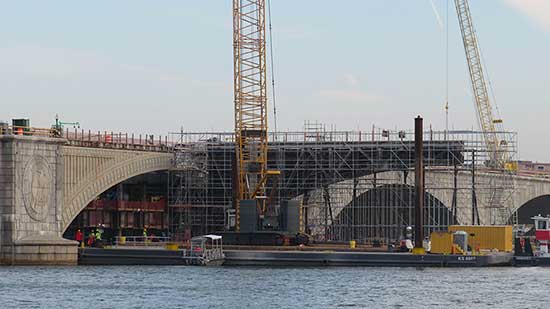
Source: National Park Service
The Biden Administration, following through on their promise to take aggressive action to tackle climate change, has taken steps that include rejoining the Paris Agreement; signing significant Executive Orders on January 27, 2021; and on March 31, unveiling a new $2 trillion American Jobs Plan focused on infrastructure modernization and resiliency, addressing climate concerns and clean economy job creation, and delivering on environmental justice promises. While the American Rescue Plan (see article below) addresses the shorter-term goals of alleviating immediate COVID-related economic, health, and social distress in communities, the American Jobs Plan would set the country on a long-term path to address the economic restructuring needed to rebuild from the pandemic impact while dealing with the climate crisis. As the White House has stated, “The American Jobs Plan will invest in America in a way we have not invested since we built the interstate highway and won the Space Race.”
Major components of the proposed plan:
- Fix highways, rebuild bridges, upgrade ports, airports, and transit systems.
- Deliver clean drinking water, a renewed electric grid, and high-speed broadband to all Americans.
- Build, preserve, and retrofit more than two million homes and commercial buildings; modernize our nation’s schools and child care facilities; and upgrade veterans’ hospitals and federal buildings.
- Solidify the infrastructure of our care economy by creating jobs and raising wages and benefits for essential home care workers.
- Revitalize manufacturing, secure U.S. supply chains, invest in R&D, and train Americans for the jobs of the future.
- Create good-quality jobs that pay prevailing wages in safe and healthy workplaces while ensuring workers have a free and fair choice to organize, join a union, and bargain collectively with their employers.
The Plan will be brought to Congress for deliberation and action throughout the summer. You can read more about the implications of the Plan for climate and jobs at this World Resources Institute blog. Find out more details about the American Jobs Plan at this White House Fact Sheet.
The American Rescue Plan Promises Recovery and Resilience
By Tracy Garland, Social Media and Events Director, R

esilient Virginia
On March 11th, President Joe Biden signed The American Rescue Plan Act (ARPA) into law. The sweeping, $1.9 trillion legislative package is designed to help the country recover from the dual public health and economic crises resulting from the Covid-19 pandemic.
The Act provides state and local governments and community organizations with substantial funding for fiscal relief, recovery, infrastructure, housing assistance, food security, and small business, nonprofit and health and human services support, and much more. For Virginia, the bill means that the state will receive about $3.8 billion and local governments will receive about $3 billion.
Each element of the recovery package can help communities not only recover from the pandemic but become more resilient to future disasters and emergencies. Volumes could be written on this topic, so below is a consolidated round-up of the best information resources we found for the ARPA and other Covid-19 recovery resources:
White House: Remarks by President Biden on the American Rescue Plan
American Rescue Plan Act of 2021: Summary. Created by Holland and Knight’s Public Policy and Regulation Group, this 20-page document summarizes the key provisions of the Act, broken down into categories including: Agriculture, Education, Disaster Relief, Water and Utility Assistance, Healthcare, Housing Assistance, Transportation, Cybersecurity, Broadband, Unemployment, and more.
US Treasury Department. “The American Rescue Plan Will Deliver Immediate Economic Relief to Families” Fact Sheet outlines how the ARPA will change the course of the pandemic, provide relief to families and workers, and build a bridge to an equitable economic recovery.
Economic Policy Institute Working Economics Blog. How the pandemic has affected state and local governments and the communities they serve, and how ARPA can clear a path to a resilient recovery.
National Association of Counties (NACO). Covid-19 Recovery Clearinghouse provides a breakdown of state and local fiscal recovery funds from the ARPA; NACO’s legislative analyses; examples and best practices for investing funds; and key considerations for vaccine distribution.
National League of Cities. Estimated State and Local Allocation Spreadsheet is a searchable reference guide for estimations of allocations from the ARPA State and Local Fiscal Relief Funds for each municipality.
Small Business Administration. The American Rescue Plan section of the SBA’s Covid-19 page provides updated information on the Paycheck Protection Program (PPP) expansion, Shuttered Venue Operators Grants, Economic Injury Disaster Loan Advance program, and more.
US Department of Agriculture. The American Rescue Plan Fact Sheet summarizes provisions within the jurisdiction of the USDA that will reduce hunger, strengthen the food supply chain, invest in rural America, and provide support to underserved, socially disadvantaged farmers.

FUNDING and RESOURCES
Energy Act of 2020 Accelerates Clean Energy Development
In late December 2020 Congress passed a massive omnibus bill, and one part of that was the Energy Act of 2020. This bill, passed with bipartisan support and representing the first comprehensive update to our nation’s energy policies in 13 years, will provide more than $35 billion for research and development funding for emissions-reducing technologies, as well as extending energy efficiency and renewable tax credits.
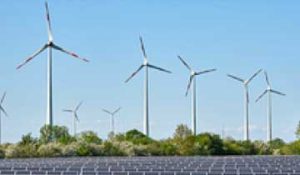 This bill provides significant opportunities to move President Biden’s greenhouse gas emission reduction goals forward, while advancing America’s long-term competitiveness in the global economy.
This bill provides significant opportunities to move President Biden’s greenhouse gas emission reduction goals forward, while advancing America’s long-term competitiveness in the global economy.
Highlights of the bill:
Extensions of tax credits include:
- Wind received a one-year extension through 2021;
- Solar received a two-year extension or delay in its phase down through 2023 for both commercial and residential (26% of the credit level continues next year, then 22% in 2023; commercial stays at 10% permanently);
- Commercial and multi-unit dwelling energy efficiency tax credits were made permanent;
- Residential efficiency incentives extended one year; and
- Electric vehicle charging infrastructure incentives also received a one-year extension of previous credits through 2021.
New tax credits
- Offshore wind will now receive a new 30% tax credit for the next five years.
Other major portions of the bill include:
- A number of provisions relating to storage, including the Better Energy Storage Technology (BEST) Act, which requires DOE to carry out a set of storage programs and develop planning;
- Carbon capture, storage, and utilization, focused on power generation and industrial facilities, as well as R&D on natural and technological CO2 removal;
- Grid modernization and integrated energy systems;
- Advanced nuclear technology; and
- R&D programs that support renewable technology development and propel the US ahead in being a global leader in climate change technology.
Read a summary of the provisions in the Energy Act of 2020 here and here.
See the perspective of the U.S Chamber of Commerce, which supported this bill, here.
Virginia Foundation Funds Local Resiliency
The PATH Foundation, based in Warrenton, decided last year to award Community Resilience Grants to help local community organizations deal with increased community needs due to COVID-19 shutdowns. At the end of 2020 they had awarded two rounds of grants, totaling more than $2.3 million. Recipients have included schools, youth engagement and health-oriented organizations, community services, and environmental groups. While the Resilience Grants cycle has now ended, the PATH Foundation continues to support community health and vitality through their grant programs. The foundation supports community organizations in Fauquier, Rappahannock, and Culpeper counties. Find out more here.
Resilient Events Calendar
This Spring, check out the many webinars, conferences, and community meetings that are happening in Virginia and around the nation.
Of special note:
May 6, 2021 — Resilient Virginia’s Spring Resiliency Academy Series: Funding for Resiliency. First Workshop: Funding Flood Prone Communities. Confirmed Speakers: Russell Baxter, Deputy Director, VADCR, and Debbie Messmer, State Hazard Mitigation Officer, VDEM. Registration opens April 19.

MEMBERSHIP
Your support helps communities move toward resiliency!
Our goals for 2021 are to continue to expand our capacity to inform, educate, and activate communities so that they can better meet the challenges of climate change, pandemics, and the wide-ranging social and economic disruption we’ve seen in the past year, while building a clean economy that strives for equality and environmental justice.
With your support we will grow our resiliency information hub, carry out workshops and conferences, and offer communities tools they need to address climate change.
You can help us reach our goals!
Your support is tax-deductible!
Thanks to our 2021
Community Leader Annual Sponsor
Thanks to Our 2020
End-of-Year Contributors
John Accordino
Ann Phillips
Marjorie Davidson
THANK YOU!
Continue your support throughout the year by using one or both of these online shopping sites that contribute to Resilient Virginia:
- Smile.Amazon.com — If Amazon is your online shopping choice, go to Smile.Amazon.com and designate Resilient Virginia and we will receive a donation with every purchase.
- GoodShop.com — Find lots of discounts and many participating stores for office supplies, general shopping, and special event gifts.
Note from Annette Osso, Editor, Resilient Virginia News — Feel free to send your suggestions for stories, as well as comments on existing stories. I am the primary manager and writer of the newsletter, except as noted with designations of authorship by other staff or invited guest writers. Contact: osso@resilientvirginia.org

